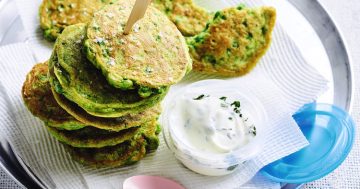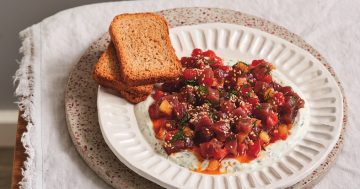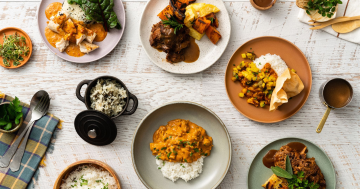By Christine Salins.
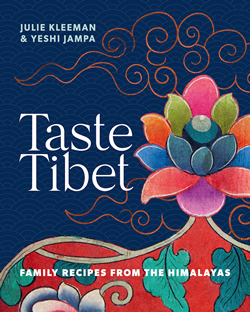 Julie Kleeman and Yeshi Jampa met in northern India in 2009 while taking pictures of snow monkeys. They had their first gastronomic experience together that evening when Yeshi cooked Julie thentuk, hand-pulled noodle soup.
Julie Kleeman and Yeshi Jampa met in northern India in 2009 while taking pictures of snow monkeys. They had their first gastronomic experience together that evening when Yeshi cooked Julie thentuk, hand-pulled noodle soup.
Yeshi’s soups and stir-fries stole Julie’s heart and they’ve been eating and cooking together ever since. Now married with two children and living in Oxford, England, they own and run a restaurant and food stall called Taste Tibet.
They’ve also just produced their first cookbook together, also called Taste Tibet, published by Murdoch Books (RRP $49.99). Both a love story and a recipe book, it throws the spotlight on a cuisine that Julie admits she knew very little about before meeting Yeshi.
“If I hadn’t met Yeshi I would have come away with a pretty sad impression of Tibetan food,” she says in the book’s introduction, noting that most visitors don’t see beyond tourist menus featuring yak burgers and yak butter tea made with rancid butter.
“At first glance, Tibetan food looks a lot like Chinese food. Noodles, dumplings and small plates are a big feature.”
Yet flavour-wise, Tibetan cuisine has more in common with the food of Bhutan, Nepal and northern India than it does with Chinese food.
“The Tibetan kitchen uses liberal amounts of Sichuan peppercorns, turmeric and cumin, and plenty of aromatics such as ginger, garlic and coriander. A distinguishing feature of the Tibetan diet is that much of it is based on barley and wheat, crops which unlike rice grow at high altitude – with bread often being the accompaniment to a main meal. There is also a fair amount of dairy, a food type largely missing from the traditional Chinese diet. Hearty soups, stews and broths are another mainstay in such a harsh environment.”
The photos and text in Taste Tibet capture the lifestyle and landscape beautifully, and the recipes explain things brilliantly. The couple are known for their delicious momos (dumplings), closely followed by their chicken curry, the recipe for which is reproduced here.
The curry is commonly served with a flatbread called balep, the recipe for which is also in the book, along with other favourites such as Potato and chickpea breakfast bomb (“the best of all hangover cures”) and a much-cherished recipe from Yeshi’s mum, Mooli and yoghurt salad (mooli is otherwise known as daikon or white radish).
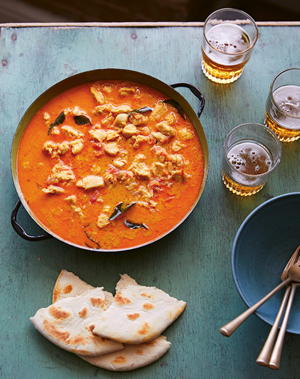 Taste Tibet Famous Chicken Curry
Taste Tibet Famous Chicken Curry
Serves 4 to 6
2 tablespoons cooking oil
2 large garlic cloves, thinly sliced
2.5 cm piece of ginger, washed but not peeled, thinly sliced
1 small red onion, thinly sliced
2 large tomatoes, thinly sliced
¼ teaspoon turmeric
1 teaspoon Bassar curry masala (or hot chilli powder)
1½ teaspoons Madras curry powder
2 tablespoons coconut milk powder
6 to 8 fresh curry leaves, or 10 to 12 dried
1 x 400 ml tin of coconut milk
600g chicken breast fillets, cut into bite-sized pieces
1 teaspoon salt
Chopped coriander to garnish – optional
Place a heavy-bottomed saucepan over a medium-high heat and add the oil. When it’s hot, add the garlic and ginger and let it brown for a couple of minutes, then add the onion and stir for a further 2 minutes. Now add the tomatoes, turmeric, curry masala and curry powder. Mix together and cook for 10 to 15 minutes, turning the heat down a little and adding about 50 ml (2½ tablespoons) of water if anything starts to catch, then add the coconut milk powder, curry leaves and coconut milk and mix thoroughly. Take your time here: you are making a curry paste, and it needs to be cooked through completely before you can add the chicken.
Now add the chicken and salt. Turn the heat back up to high, stir the chicken through the sauce and cook for 8 to 10 minutes, adding a little boiling water – but only a little – if anything sticks. The pan should be quite dry to begin with, before the juices from the chicken start to be released, so wait a while before adding any water.
After the chicken has been in for 8 minutes, check to make sure it is fully cooked. To do this, take a piece out and cut it through the middle – it should be white all the way through. If the sauce looks too thick, add a little more boiling water and stir briskly for 2 minutes. Garnish with coriander, if you like, then serve.
Recipe and images from Taste Tibet by Julie Kleeman and Yeshi Jampa, photography by Ola O. Smith. Murdoch Books RRP $49.99.


